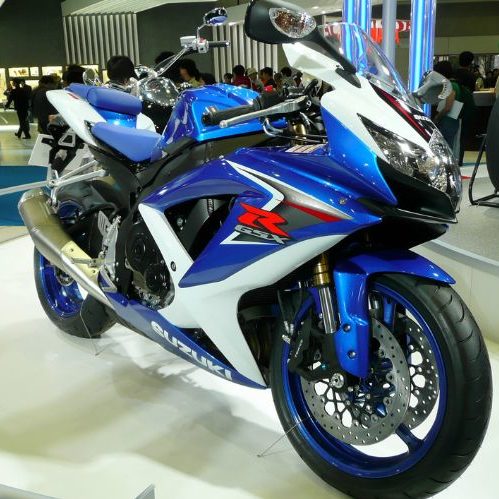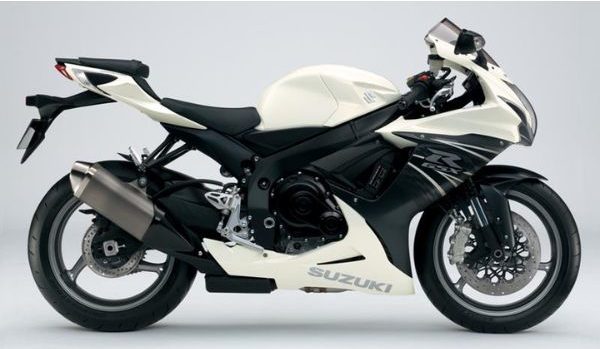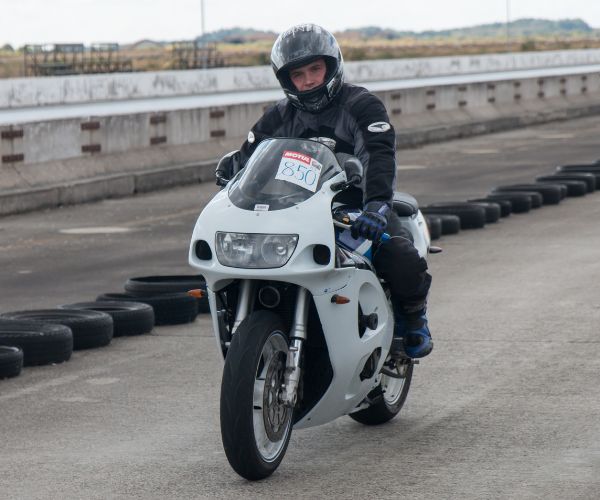Production dates – 1992 to Present (There were no GSX-R600s produced between 1994-1996)
In 1985 Suzuki released a motorcycle that would change the sportbike category forever. Little did they know that the release of the GSX-R750 was also the start of one of their most iconic lines.
In the years that followed, the GSX-R would be produced in various capacities, and in 1992 the first GSX-R600 was released.
The GSX-R600 has been a forerunner in the 600cc class ever since and today remains as stable as ever.
Let’s take a look at the GSX-R600, the good, the bad, and the ugly.
Suzuki GSX-R600 History

There have been 7 generations of the GSX-R600, and with each generation, significant engineering and design improvements have been made.
Key things to note for each generation are as follows:
- 1992 – Original model
- 1997 Second Gen – Fitted with SRAD (Suzuki Ram Air Direct)
- 2001 Third Gen – Received Fuel Injection
- Fourth and Fifth Gen – Mainly cosmetic changes and updates
- 2008 Sixth Gen – Complete redesign and fitted with SDTV (Suzuki Dual Throttle Valve)
- 2011 Seventh Gen – Redesigned to be shorter and lighter
Today the GSX-R600 is as good as ever, with all the original DNA being passed down fused with modern technology and riding features that make this 600 a serious street or track weapon.
Engine and Transmission
At the heart of the bike is the compact, fuel-injected 599cc, four-cylinder that hasn’t changed all that much over the years.
The top end of the engine is tilted forward, which is intended to improve cylinder head charging for increased power output.
The engine design has been developed from Suzuki’s involvement in MotoGP. It has an over-square bore/stroke ratio for strong high-rpm power delivery, and the camshafts have aggressive valve-lift profiles.
Suzuki’s ECM does all the engine management with settings tailored to suit the intake and exhaust systems for accurate, smooth throttle response and improved fuel economy.
The drive-mode selector (S-DMS) offers a choice of two control maps to suit the road or track.
The engine is mated to a six-speed transmission with a tall first-gear ratio and shorter ratios for second-fourth. This means racers off the line can get a quick start but maintain speed and acceleration on the straight and in the corners.
The engine of the GSX-R600 is basic but powerful, loaded with torque, and more than capable of what it is intended.

The midrange torque makes the bike special. It has enough grunt for you to make the mistake of thinking you are riding something bigger. Equally, it will pull you to the redline forcing you to push your limits and see what the bike is made of.
One characteristic of the GSX-R600 is that while it has the top end should you desire it, overall, the nature of the engine is relatively easygoing.
It is smooth, easy to ride, and doesn’t need to be pushed hard to be enjoyable.
The racing genes are there, ready and willing, but if you just want to enjoy your ride in the twisties on a sunny day, then the bike will do just that and put you at ease.
Chassis, Suspension, Brakes
It isn’t just the engine that has the race-proven design; this is also accurate for the rest of the bike.
The twin-spar aluminum alloy frame has plenty of built-in flex. It is light, short and narrow, paired with a lightweight swingarm.
Built of five cast sections, the idea was to ensure a balance of strength and low weight.
On the front, you have the race-developed Showa Big Piston Fork. You can adjust them to suit your riding perfectly, and they give a very solid feel on the front, increasing confidence in corners.
On the rear, the multi-piece rear sub-frame and swingarm are supported by the single Showa shock, which is adjustable all round again for the perfect tailoring to your needs.
Brembo brakes on the front and Nissin on the rear provide masses of stopping power and are more than fit for purpose both on the street and track.
Overall the chassis feels very stable at slow and high speeds. You immediately feel comfortable and ready to push the bikes and your limits.
Feedback is excellent, but the steering may be slower compared to others in the same class.
Handling, Comfort, Styling

In terms of styling, the bike is very much a traditional GSX-R, it is nothing special, and you would be hard-pressed to spot the difference between models of the last few years aside from paintwork.
For some, this traditional styling is perfect, and there is some merit in retaining a style that has worked for so long. However, others would like to see the GSX-R600, and arguably, others in the GSX-R line receive a facelift.
Suzuki has carefully considered the riders’ comfort with the GSX-R600. It is less aggressive in its riding stance than some of the competition, with the clip-on bars not too far out of reach and the seat more than up to the task of a long day’s ride.
Three-way adjustable footpegs allow for the shortest rider to be comfortable, and those needing more legroom are equally accommodated.
If desired, you wouldn’t struggle to set the model up as a sports tourer.
The GSX-R600 is a serious racer. If you want to twist the throttle and brawl it out on the track, it can be a monster. You will feel stable, confident, and safe and get all the feedback you need to make the quick decisions required when riding at speed.
However, it can also be super tame and calm-natured, which makes it up to the task of riding around the city.
How does it stand up against the competition?
The main competitors for the GSX-R600 are the Kawasaki Ninja ZX-6R, the Honda CBR600RR, and the recently discontinued Yamaha R6.
In terms of agility and precise steering, the GSX-R falls slightly behind as it can feel lumpy and slow in steering compared to the ZX-6R.
The GSX-R600 is also lacking in technology and rider aids when compared to other bikes in the class. There is nothing fancy about the Suzuki; it is a straight, bare, bones 600cc racer and isn’t trying to be anything more than that.
For example, the ZX-6R is equipped with a quick shifter, assist and slipper clutch, traction control, power modes, and ABS as an option.
Honda’s CBR600RR is also pretty bare, but it does feature Honda’s selectable Torque Control and an assisted slipper clutch.
Whether the Suzuki lacking a little in tech is a negative thing is up to the rider. Personally, I like the no-frills approach, and I may be turning into a dinosaur, but on a straight racer, the fun is testing your skills.
Some bikes are eliminating aspects of rider skill with all the rider aids they are now loaded with.
In terms of price, the GSX-R is on par with the ZX-6R, whereas the CBR is significantly more costly.
Interestingly in terms of performance specs, the GSX-R beats off all of the bikes in the 600cc class with more power, more torque, and an estimated top speed shared jointly with the Yamaha R6.
Specs
Engine and Transmission
- Engine – Four-stroke, liquid-cooled, four-cylinder, DOHC
- Capacity – 599cc
- Bore x Stroke – 67 x 42.5mm
- Compression Ratio – 12.9:1
- Cooling System – Liquid
- Starting – Electric
- Induction – Fuel Injection
- Transmission – 6-speed
- Final Drive – Chain
- Clutch – Wet, multi-plate
- Max Power – 126 horsepower
- Max Torque – 69Nm
- Top Speed – 165mph
Chassis and Dimensions
- Frame – Twin spar, aluminum alloy
- Front Suspension – Showa Big Piston Fork
- Rear Suspension – Single Showa rear shock
- Front Brakes – Brembo, 4-piston, twin discs
- Rear Brakes – Nissin, 1-piston, single disc
- Wheelbase – 1385mm
- Length – 2030mm
- Width – 1135mm
- Seat Height – 810mm
- Curb Weight – 187 kg
Buying One – What To Look Out For?
If you are looking for a brand new 2023 Suzuki GSX-R600, the base MSRP is $11,699.
However, since the model has been in production since 1992, there are plenty of models on the used market to choose from.
The good news is that the latest generation (7th) has been pretty much the same since 2011, so opting for a bike a few years old means you won’t miss out on any new tech advancements or engine upgrades.
Prices for a used GSX-R600 vary from $6,000 to $10,000 depending on age, condition, mileage, etc.
There are some key things to be aware of when buying a used GSX-R600:
- As with all sportbikes, there is a risk that the previous owner will have dropped or crashed the bike at some point, and while they may be honest about cosmetic damage, there could be some structural damage that hasn’t been addressed.
- Be sure to check the fairings for cracks or if they are mismatched, as this is an indication of the bike being dropped.
- Replacing fairings with matching colorways is always an expensive task, so be prepared to search for the right plastics or factor in the cost of having the bike wrapped or resprayed.
- Check out the wear on the tire; this will give you an indication of how hard the bike has been ridden.
- Be sure to check for any oil leaks, make sure the chain is properly lubricated, and listen for any unusual sounds like knocking when the engine is running.
- By doing basic checks such as this, you are checking the previous owner has looked after the bike and not run it into the ground. Asking for paperwork and service history will give you some peace of mind that the owner has taken care of the bike.
- A model a few years old may be best purchased from a dealer who can offer you a warranty and will have done full checks on the bike.
Generally, parts for a GSX-R600 are pretty cheap, maintenance is affordable, and they are solid machines, ready to take some abuse as it is in their nature as racers.
Final Thoughts
While the GSX-R600 might not be the most agile or advanced in the class, it is a rugged, tough motorcycle, a sportsbike in the truest sense.
It holds the road, is comfortable, stable, powerful, and is ready to race at the twist of the wrist but will calmly glide you to your destination if that is more your speed.
The GSX-R600 also tops the list among the competition for its engine performance.
So if you want a get-down-and-dirty kind of sportsbike (which, let’s face it, is why they exist), then you can’t go wrong with a GSX-R600.
Image Credits
PekePON, CC BY-SA 3.0, via Wikimedia Commons
Pompitomoyo, CC BY-SA 3.0, via Wikimedia Commons
Johannes Maximilian, GFDL 1.2, via Wikimedia Commons